Page 475 of 684
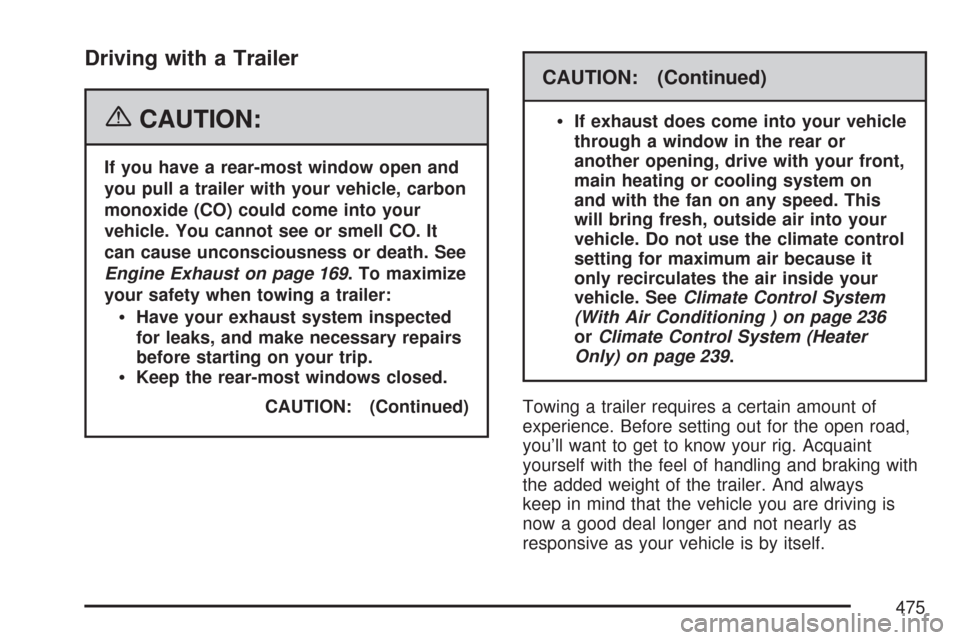
Driving with a Trailer
{CAUTION:
If you have a rear-most window open and
you pull a trailer with your vehicle, carbon
monoxide (CO) could come into your
vehicle. You cannot see or smell CO. It
can cause unconsciousness or death. See
Engine Exhaust on page 169. To maximize
your safety when towing a trailer:
Have your exhaust system inspected
for leaks, and make necessary repairs
before starting on your trip.
Keep the rear-most windows closed.
CAUTION: (Continued)
CAUTION: (Continued)
If exhaust does come into your vehicle
through a window in the rear or
another opening, drive with your front,
main heating or cooling system on
and with the fan on any speed. This
will bring fresh, outside air into your
vehicle. Do not use the climate control
setting for maximum air because it
only recirculates the air inside your
vehicle. SeeClimate Control System
(With Air Conditioning ) on page 236
orClimate Control System (Heater
Only) on page 239.
Towing a trailer requires a certain amount of
experience. Before setting out for the open road,
you’ll want to get to know your rig. Acquaint
yourself with the feel of handling and braking with
the added weight of the trailer. And always
keep in mind that the vehicle you are driving is
now a good deal longer and not nearly as
responsive as your vehicle is by itself.
475
Page 487 of 684
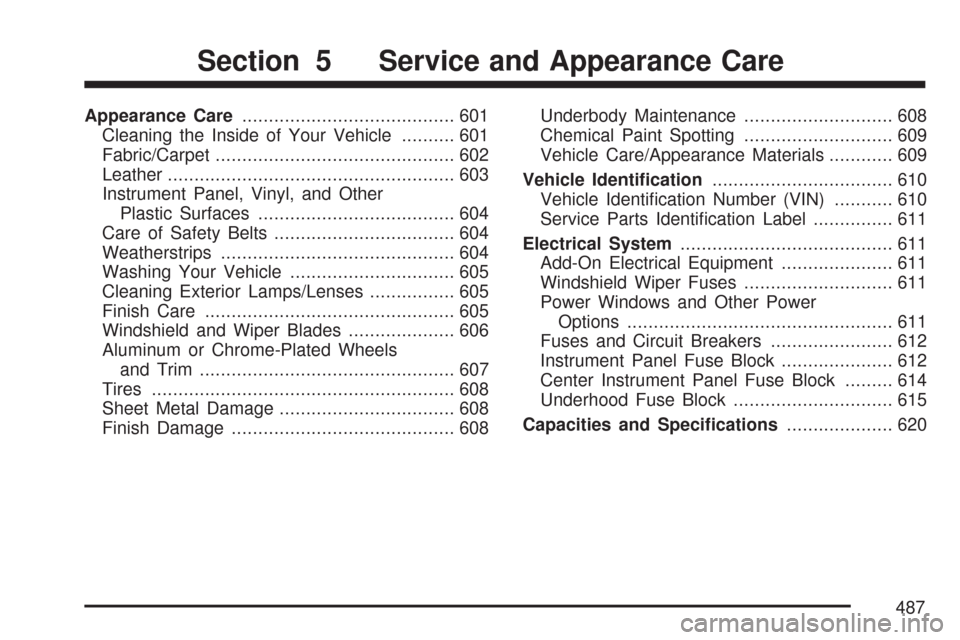
Appearance Care........................................ 601
Cleaning the Inside of Your Vehicle.......... 601
Fabric/Carpet............................................. 602
Leather...................................................... 603
Instrument Panel, Vinyl, and Other
Plastic Surfaces..................................... 604
Care of Safety Belts.................................. 604
Weatherstrips............................................ 604
Washing Your Vehicle............................... 605
Cleaning Exterior Lamps/Lenses................ 605
Finish Care............................................... 605
Windshield and Wiper Blades.................... 606
Aluminum or Chrome-Plated Wheels
and Trim................................................ 607
Tires......................................................... 608
Sheet Metal Damage................................. 608
Finish Damage.......................................... 608Underbody Maintenance............................ 608
Chemical Paint Spotting............................ 609
Vehicle Care/Appearance Materials............ 609
Vehicle Identi�cation.................................. 610
Vehicle Identi�cation Number (VIN)........... 610
Service Parts Identi�cation Label............... 611
Electrical System........................................ 611
Add-On Electrical Equipment..................... 611
Windshield Wiper Fuses............................ 611
Power Windows and Other Power
Options.................................................. 611
Fuses and Circuit Breakers....................... 612
Instrument Panel Fuse Block..................... 612
Center Instrument Panel Fuse Block......... 614
Underhood Fuse Block.............................. 615
Capacities and Speci�cations.................... 620
Section 5 Service and Appearance Care
487
Page 519 of 684
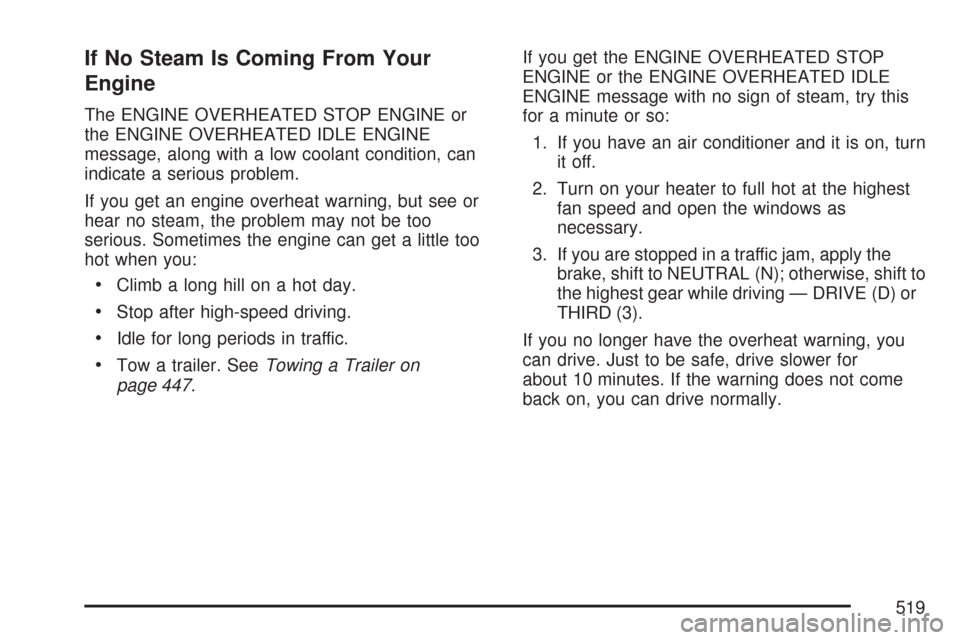
If No Steam Is Coming From Your
Engine
The ENGINE OVERHEATED STOP ENGINE or
the ENGINE OVERHEATED IDLE ENGINE
message, along with a low coolant condition, can
indicate a serious problem.
If you get an engine overheat warning, but see or
hear no steam, the problem may not be too
serious. Sometimes the engine can get a little too
hot when you:
Climb a long hill on a hot day.
Stop after high-speed driving.
Idle for long periods in traffic.
Tow a trailer. SeeTowing a Trailer on
page 447.If you get the ENGINE OVERHEATED STOP
ENGINE or the ENGINE OVERHEATED IDLE
ENGINE message with no sign of steam, try this
for a minute or so:
1. If you have an air conditioner and it is on, turn
it off.
2. Turn on your heater to full hot at the highest
fan speed and open the windows as
necessary.
3. If you are stopped in a traffic jam, apply the
brake, shift to NEUTRAL (N); otherwise, shift to
the highest gear while driving — DRIVE (D) or
THIRD (3).
If you no longer have the overheat warning, you
can drive. Just to be safe, drive slower for
about 10 minutes. If the warning does not come
back on, you can drive normally.
519
Page 558 of 684
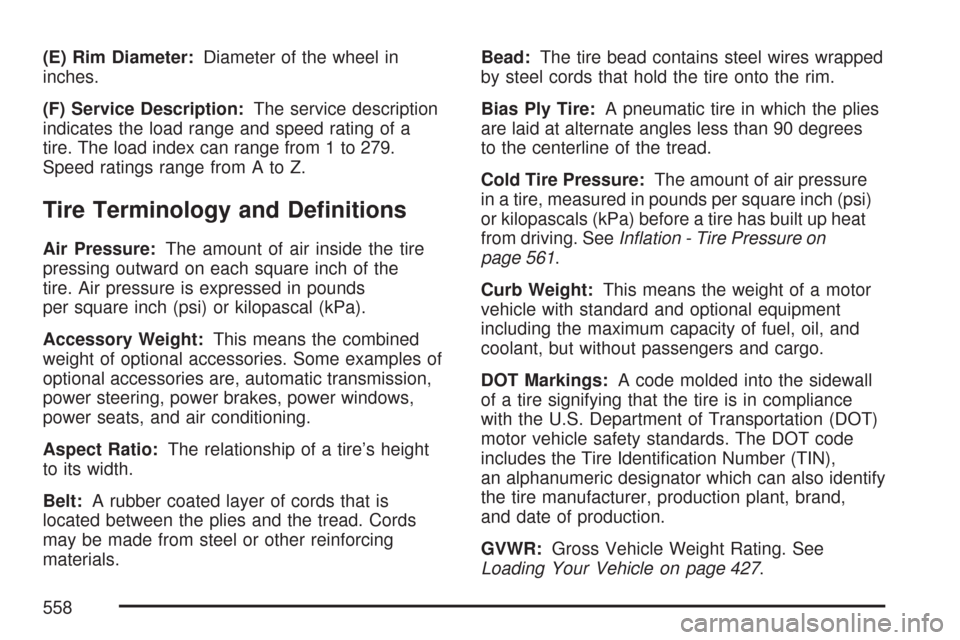
(E) Rim Diameter:Diameter of the wheel in
inches.
(F) Service Description:The service description
indicates the load range and speed rating of a
tire. The load index can range from 1 to 279.
Speed ratings range from A to Z.
Tire Terminology and De�nitions
Air Pressure:The amount of air inside the tire
pressing outward on each square inch of the
tire. Air pressure is expressed in pounds
per square inch (psi) or kilopascal (kPa).
Accessory Weight:This means the combined
weight of optional accessories. Some examples of
optional accessories are, automatic transmission,
power steering, power brakes, power windows,
power seats, and air conditioning.
Aspect Ratio:The relationship of a tire’s height
to its width.
Belt:A rubber coated layer of cords that is
located between the plies and the tread. Cords
may be made from steel or other reinforcing
materials.Bead:The tire bead contains steel wires wrapped
by steel cords that hold the tire onto the rim.
Bias Ply Tire:A pneumatic tire in which the plies
are laid at alternate angles less than 90 degrees
to the centerline of the tread.
Cold Tire Pressure:The amount of air pressure
in a tire, measured in pounds per square inch (psi)
or kilopascals (kPa) before a tire has built up heat
from driving. SeeIn�ation - Tire Pressure on
page 561.
Curb Weight:This means the weight of a motor
vehicle with standard and optional equipment
including the maximum capacity of fuel, oil, and
coolant, but without passengers and cargo.
DOT Markings:A code molded into the sidewall
of a tire signifying that the tire is in compliance
with the U.S. Department of Transportation (DOT)
motor vehicle safety standards. The DOT code
includes the Tire Identi�cation Number (TIN),
an alphanumeric designator which can also identify
the tire manufacturer, production plant, brand,
and date of production.
GVWR:Gross Vehicle Weight Rating. See
Loading Your Vehicle on page 427.
558
Page 601 of 684
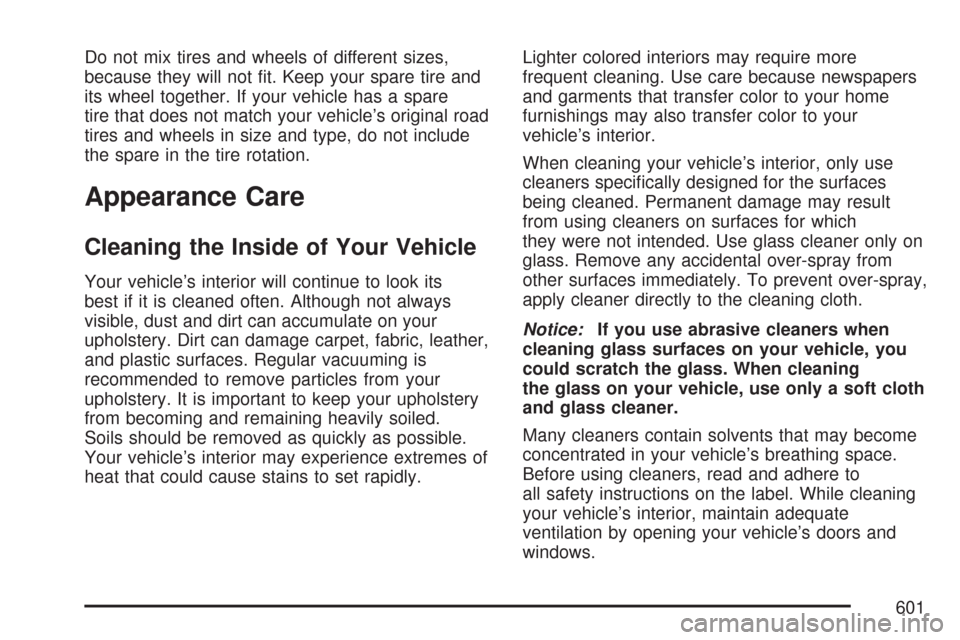
Do not mix tires and wheels of different sizes,
because they will not �t. Keep your spare tire and
its wheel together. If your vehicle has a spare
tire that does not match your vehicle’s original road
tires and wheels in size and type, do not include
the spare in the tire rotation.
Appearance Care
Cleaning the Inside of Your Vehicle
Your vehicle’s interior will continue to look its
best if it is cleaned often. Although not always
visible, dust and dirt can accumulate on your
upholstery. Dirt can damage carpet, fabric, leather,
and plastic surfaces. Regular vacuuming is
recommended to remove particles from your
upholstery. It is important to keep your upholstery
from becoming and remaining heavily soiled.
Soils should be removed as quickly as possible.
Your vehicle’s interior may experience extremes of
heat that could cause stains to set rapidly.Lighter colored interiors may require more
frequent cleaning. Use care because newspapers
and garments that transfer color to your home
furnishings may also transfer color to your
vehicle’s interior.
When cleaning your vehicle’s interior, only use
cleaners speci�cally designed for the surfaces
being cleaned. Permanent damage may result
from using cleaners on surfaces for which
they were not intended. Use glass cleaner only on
glass. Remove any accidental over-spray from
other surfaces immediately. To prevent over-spray,
apply cleaner directly to the cleaning cloth.
Notice:If you use abrasive cleaners when
cleaning glass surfaces on your vehicle, you
could scratch the glass. When cleaning
the glass on your vehicle, use only a soft cloth
and glass cleaner.
Many cleaners contain solvents that may become
concentrated in your vehicle’s breathing space.
Before using cleaners, read and adhere to
all safety instructions on the label. While cleaning
your vehicle’s interior, maintain adequate
ventilation by opening your vehicle’s doors and
windows.
601
Page 611 of 684
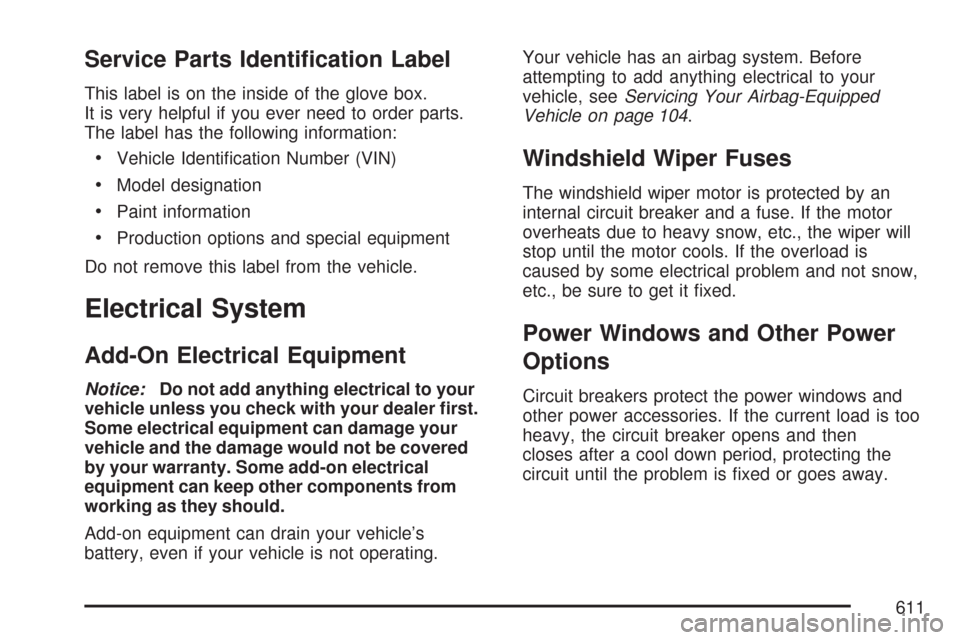
Service Parts Identi�cation Label
This label is on the inside of the glove box.
It is very helpful if you ever need to order parts.
The label has the following information:
Vehicle Identi�cation Number (VIN)
Model designation
Paint information
Production options and special equipment
Do not remove this label from the vehicle.
Electrical System
Add-On Electrical Equipment
Notice:Do not add anything electrical to your
vehicle unless you check with your dealer �rst.
Some electrical equipment can damage your
vehicle and the damage would not be covered
by your warranty. Some add-on electrical
equipment can keep other components from
working as they should.
Add-on equipment can drain your vehicle’s
battery, even if your vehicle is not operating.Your vehicle has an airbag system. Before
attempting to add anything electrical to your
vehicle, seeServicing Your Airbag-Equipped
Vehicle on page 104.
Windshield Wiper Fuses
The windshield wiper motor is protected by an
internal circuit breaker and a fuse. If the motor
overheats due to heavy snow, etc., the wiper will
stop until the motor cools. If the overload is
caused by some electrical problem and not snow,
etc., be sure to get it �xed.
Power Windows and Other Power
Options
Circuit breakers protect the power windows and
other power accessories. If the current load is too
heavy, the circuit breaker opens and then
closes after a cool down period, protecting the
circuit until the problem is �xed or goes away.
611
Page 614 of 684
Circuit Breaker Usage
LT DRDriver’s Side Power Window Circuit
Breaker
Harness
ConnectorUsage
LT DR Driver’s Door Harness Connection
BODY Harness Connector
BODY Harness Connector
Center Instrument Panel Fuse Block
The center instrument panel fuse block is
located underneath the instrument panel, to the
left of the steering column.
Top View
Harness
ConnectorUsage
BODY 2 Body Harness Connector 2
BODY 1 Body Harness Connector 1
BODY 3 Body Harness Connector 3
HEADLINER 3 Headliner Harness Connector 3
HEADLINER 2 Headliner Harness Connector 2
HEADLINER 1 Headliner Harness Connector 1
614
Page 615 of 684
Harness
ConnectorUsage
BRAKE
CLUTCHBrake Clutch Harness Connector
SEO/UPFITTERSpecial Equipment Option Up�tter
Harness Connector
Circuit Breaker Usage
CB1Passenger’s Side Power Window
Circuit Breaker
CB2 Passenger’s Seat Circuit Breaker
CB3 Driver’s Seat Circuit Breaker
CB4 Not Used
Underhood Fuse Block
The underhood fuse block is located in the engine
compartment, on the driver’s side of the vehicle.
Lift the cover to access
the fuse block.
To remove fuses, hold the end of the fuse
between your thumb and index �nger and pull
straight out.
615